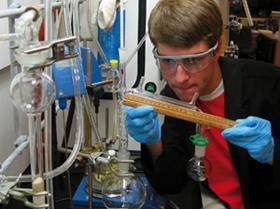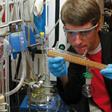Dylan Stiles explains why he loves to go skydiving in a lab coat
Greetings, fellow chemists. I am writing to you from California, US, in my first composition for Chemistry World. Allow me to introduce myself. In my former internet life I was mostly known as the author of a little blog called tenderbutton.com. You may or may not have heard of it, but it doesn’t matter because I’ve turned off the lights at tenderbutton. Presently I’m in the sunset years of my PhD, where I’ve been steeped in synthetic organic chemistry - natural product synthesis to be specific. I have to say that I positively love it, and here’s why.

The objective of synthesis - reacting two chemicals to form a new molecule - is the ultimate creative process. We have the tools to prepare almost any molecule we want, and there is a very real chance that a small molecule, yet to be synthesised, can treat or cure cancer/malaria/any other illness more effectively than anything currently available.
Right now, this molecule lies in its component pieces within the pages of the Aldrich catalogue, and it’s just a matter of time before someone assembles it. I find this alluring and it’s what gets me out of bed in the morning.
I’ve always felt there’s a certain irony in the term ’organic chemistry’ itself. One usually associates ’organic’ with all-natural granola and free-range chicken. In reality, set foot inside an organic lab and you will find yourself surrounded by some of the most toxic and temperamental substances known to man. There’s nothing healthy or natural about that bottle of diethylzinc that’s just waiting for you to accidentally expose it to air so it can burst into flames and wreak havoc.
Therein lies the adventure. Synthesis is an academically sanctioned opportunity to live on the edge. Handling dangerous materials can be thrilling, like skydiving in a lab coat. Anyone who has ever put their mettle to the test and stood behind a blast shield while generating diazomethane knows that magical feeling I’m talking about.
Organic chemistry provides a visceral satisfaction that few other sciences can achieve. I’ll compare and contrast with biology, since I’ve tried them both. Biology is a world filled with clear aqueous solutions where you transfer microlitre volumes from one tube to another, cross your fingers and hope that unseen interactions will occur. Qualitative measurements like ’units of activity’ abound, so that when something doesn’t work all you can do is assume you used the wrong laboratory mouse.
Now consider the love of my life, synthetic organic chemistry. There’s no questioning the activity of your reagents when you quench a large-scale lithium aluminum hydride reduction a little too quickly and the evolved hydrogen shoots the stopcock off the flask, hitting you in the face. That 24/40-sized bruise on your forehead is an indelible reminder of the forces you’re dealing with. And you can tell from the other side of the room that your neighbour’s Moffat-Swern oxidation worked like a champ, given the penetrating stench of dimethylsulfide.
Maybe there is some truth to Hollywood’s picture of the mad scientist tinkering away in his basement lab. Exhibit A: Walter Büchi’s gift to the world, the rotary evaporator. This one’s always a crowd pleaser on lab tours because it incorporates several of chemistry’s most visually appealing elements: bubbling, dripping, and spinning. A roundbottom flask with a magnetic stir bar, half full of boiling liquid, with a reflux condenser on top incorporates all three of these elements. Perhaps this is why such a setup has remained so popular over the decades.
So when I get down to brass tacks about what I do for a living, it’s simply this: get out of bed, put on the lab coat, and make some new molecules. It’s a good life.














No comments yet